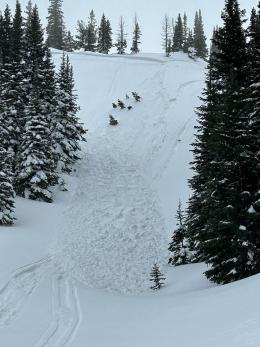Good morning. This is Doug Chabot with the Gallatin National Forest Avalanche Forecast on Thursday, January 12th at 6:45 a.m. This information is sponsored by BWAGs, Chad Bunting-Financial Advisor-Edward Jones and Pine Edge Cabins. This forecast does not apply to operating ski areas.
In the last 24 hours the mountains around Big Sky to West Yellowstone and Cooke City received 1-2” of snow. Skies are clearing, wind is blowing W-SW at 10-20 mph and gusting to 35 mph, and temperatures are in the teens (F). Today will warm into the mid-20’s with ridgetop wind blowing 10-20 mph from the W-SW. No new snow is expected in the coming days, just sunny skies.
Since Sunday morning 10-14” fell in the southern mountains including Cooke City. A few avalanches were reported, mostly human triggered and small. These broke either underneath recent wind-loads or at the new/old snow interface. A list can be found on our Avalanche Activity page.
There are 2 weak layers we are concerned about: a recently buried layer of feathery surface hoar crystals one foot deep, and a thick layer of larger facets near the ground. The layer at the ground is less reactive but could be triggered from shallow spots resulting in a large avalanche. The buried surface hoar is assumed to be everywhere. On some slopes, like around Hebgen Lake (observation), it is reactive with whumpfs and poor test scores while on other slopes it is not. Dave explains in these 2 videos (Lionhead, Taylor Fork) that we need to look for these layers. Ian and I found surface hoar in Cooke City on Tuesday (video 1) and spent yesterday morning riding around and tracking its distribution (video 2). We found it on different aspects and elevations in all 5 of our pits. It may become reactive with more snow or already be primed to slide on slopes with wind-drifting.
We are making a big deal about buried surface hoar because it’s a big deal. It is notorious for spotty distribution and for catching even seasoned professionals off guard. For today, avalanches are possible and the danger is rated MODERATE.
Our field visits and public observations in the mountains around Bozeman and Big Sky showed instability last weekend. A natural avalanche near Fairy Lake, snowmobiler and snowboarder avalanches at Buck Ridge, a skier triggered slide in the Big Sky sidecountry, and a large avalanche on Saddle Peak last Friday illustrate the lingering issue of unstable snow. Without snowfall, avalanches are getting more difficult to trigger with each passing day. The weak snow near the ground is still weak and thin layers of faceted snow mid-pack could also break (Dave’s video). Mother Nature is not giving us daily clues regarding instability, so we need to be diligent in our assessment and travel smart. Digging and testing is always a good idea because sometimes we find the unexpected. It’s also the time when traveling one at a time and carrying rescue gear can save us if we make a mistake. For today, triggering avalanches is possible and the danger is rated MODERATE.
Please share avalanche, snowpack or weather observations via our website, email (mtavalanche@gmail.com), phone (406-587-6984), or Instagram (#gnfacobs).
There are 2 weak layers we are concerned about: a recently buried layer of feathery surface hoar crystals one foot deep, and a thick layer of larger facets near the ground. The layer at the ground is less reactive but could be triggered from shallow spots resulting in a large avalanche. The buried surface hoar is assumed to be everywhere and may become reactive with more snow or already be primed to slide on slopes with wind-drifting. A snowmobiler triggered slide near Mt. Jefferson is evidence of the current instability.
Upcoming Avalanche Education and Events
Our education calendar is full of awareness lectures and field courses. Check it out: Events and Education Calendar.
TONIGHT! Jan 12th, 6:30 p.m., 1hr avalanche awareness for mechanized users at BSCO BASE in Big Sky. Free.
Every Saturday, 10 a.m. - 2:00 p.m. Avalanche Rescue Training, drop in for any amount of time. Round Lake Warming Hut, Cooke City. Free.
Loss in the Outdoors, is a support group for those who have been affected by grief and loss related to outdoor pursuits. Check out the link for more information.
On Saturday in Colorado, two snowmobilers were caught, buried, and killed in a large avalanche on the east face of Mount Epworth, about 6 miles east of Winter Park. Grand County Sheriff's Deputies and search and rescue were unable to locate the second rider before dark, but found the second rider deceased yesterday. (Preliminary report).



